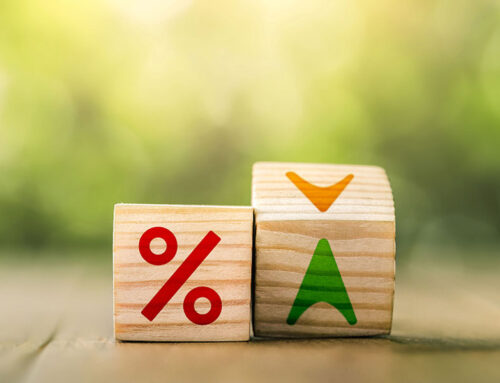I spent a little time last weekend reviewing the beginner’s guide to real estate investing that one of the younger racquetball players at the club brought with him to practice. It wasn’t a bad introduction on how and where he could get started. After talking with Charlie in more detail about his investment goals, however, it was clear that he was leaning more towards purchasing investment property to hold as a rental than buying houses to renovate and sell. The distinction was important to make since the strategy for realizing returns on each vary. With rentals, for example, it’s critical to know how to calculate the cap rate for income property before you buy to determine if the returns generated make it worth it. When Charlie said he didn’t know the first thing about cap rates, I offered to fill him in and to teach him how to do it quickly so that he’d be ahead of the curve once he started investing. And, I assured him, it’s much easier to get good at than racquetball.
How to Quickly Calculate the Cap Rate for Income Property
If your goals are similar to Charlie’s in that you’d like to start investing in real estate rentals as a means for earning passive income, then knowing a property’s cap rate is your first step in deciding whether or not it’s worth the investment. Beyond the simple calculations, however, you’ll want to figure out what the cap rate means for your investment goals and how it compares to other investment opportunities that may be before you. Some investors, like me, require that income-producing properties meet a minimum cap rate to even be considered as a reliable source for making passive income from real estate investing. Otherwise, the risk of losing money is too great should unforeseen circumstances, like prolonged vacancies or a downshift in the market overall, occur. But, cap rates are also helpful when comparing properties. If the estimated ROI on one property is 6% and the estimated ROI on another is 9%, the property with the higher rate of return, or cap rate, may be the better deal.
The capitalization rate of a property, which is the ratio of that property’s net income to the original purchase price, or capital cost, is the main indicator of the returns you can expect to receive on your investment. So, how do you determine a property’s cap rate? Luckily, it’s pretty easy. In short, here’s the formula:
(Property’s Annual Gross Income – Operating Expenses) / Purchase Price = Cap Rate
Let’s dive a little deeper to get a better understanding. What if, for example, you’re thinking of purchasing an income-producing property in Chicago for $500,000. Here are the steps you need to take to evaluate its potential return on investment:
- Calculate yearly gross income. To calculate the yearly gross income for a property, multiply the monthly income being generated by 12 months. The monthly income could already be set by the amount existing tenants pay, usually presented in a document called a rent roll, or it could be what you intend to charge for rent based on the market rates of similar properties in the area. So, assuming tenants are currently in place and the rent roll indicates they pay $2,500 each month, your yearly gross income for the home would be $39,000.
$2,500 (Property’s Monthly Income) x 12 (Months) = $39,000 (Yearly Gross Income)
- Calculate yearly net income. To calculate the yearly net income for your Chicago investment property, add up all of the property’s operating expenses for the year and subtract the total from the gross income amount. Your operating expenses include everything from maintenance costs to protecting your investment with property insurance. You’ll want to include things like management fees and property taxes, too. What you cannot include are your purchasing costs or your mortgage payments. Bearing that in mind, if the total of your yearly operating expenses equals $10,000 and you subtract that from your gross income of $39,000, you’re left with a net of $20,000.
$39,000 (Gross Income) – $10,000 (Operating Expenses) = $20,000 (Net Income)
- Divide net income by purchase price. After calculating the property’s net income, divide that number by your intended purchase price. Your purchase price may or may not be close to the list price for the property if you found it on the open market. Though, you’re more likely to pay less for a house if you have a way to find off-market properties that not everyone is competing for. The result of this calculation, which will be a percentage, is your cap rate. Therefore, a net income of $20,000 divided by a purchase price of $500,000 gives you 0.04 or a 4% expected return on your investment.
$20,000 (Net Income) / $500,000 (Purchase Price) = 4% Cap Rate
There are a few additional points to keep in mind when it comes to calculating the cap rate on income property, however. First, it’s possible you won’t know exact numbers when tallying operating expenses for a property you don’t yet own. And, there may not be any rent rolls to review, either. If, for example, you’ve purchased a single-family home as investment property that’s never been rented before, you’ll have to rely on the net operating incomes of comparable rental homes in the area to help estimate your own numbers. Second, the amount you pay for a property should, ideally, be less than its current market value for you to get the most bang for your buck. And, any of the renovations you perform should help to increase its market value. That way, you have a better chance of realizing higher returns both when you rent the house to tenants now and when you decide to sell your investment property later.
And, since the purchase price of a property is a crucial component for realizing potentially good returns, it’s critical that you get that number right before ever making an offer. In order to do that, you’ll need access to a real estate investment analysis and valuation tool that calculates all the numbers—including your renovation costs—quickly and accurately. There are several on the market to choose from. But, there’s only one that I felt was worth recommending to Charlie—and, you.
Achieve an Optimal Cap Rate by Calculating More Accurate Numbers
In addition to getting top-notch training as a real estate investor, when you become an independently owned and operated HomeVestors® franchisee, like me, you also get access to ValueChek™. This proprietary analysis and valuation software helps you estimate the most critical costs associated with buying a property so that you don’t pay too much and, as a result, diminish your potential income property cap rate. And, you can do your calculations from your iPad while on site. So, you’ll always know what price to offer, or if you should offer at all, quickly. Plus, it’s easier to learn, and master, than racquetball—just ask Charlie.
To improve your chances of realizing potentially good returns, get your hands on a great set of tools. Call HomeVestors® now to access ValueChek™ as a member of the team today.
Each franchise office is independently owned and operated.
Contact
"*" indicates required fields






